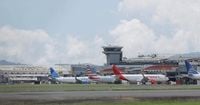Chaos erupted in Costa Rica’s skies early on September 24, 2025, when a sudden electrical failure crippled the radar system at Juan Santamaría International Airport, the country’s busiest air hub. With the radar out of commission, the Directorate General of Civil Aviation was left with little choice: Costa Rica’s entire airspace was shut down just after 6:00 a.m., halting all flights in and out of the country and leaving thousands of travelers stranded or scrambling for answers.
According to Reuters, the closure lasted at least five hours, bringing domestic and international travel to a grinding halt at both Juan Santamaría, just outside the capital San José, and Daniel Oduber Quiros International Airport in Guanacaste. The impact was immediate and far-reaching. AP reported that no planes were allowed to take off or land during the blackout, and airlines quickly took to social media to advise passengers to contact them directly to reschedule flights or seek further information.
The numbers tell the story of a country brought to an unexpected standstill. Aeris, the operator of Juan Santamaría, confirmed that 4,580 passengers were directly affected by the suspension of operations at the airport. The ripple effect was immense: 64 commercial flights, 65 domestic flights, and eight cargo flights were interrupted, according to Aeris data cited by Q COSTARICA. At least 44 flights at Juan Santamaría alone were delayed, canceled, or rerouted, with additional impacts at Guanacaste Airport, where Alaska Airlines flight AS1372 from Los Angeles—carrying 140 passengers—was among those affected.
Guanacaste Airport operations manager Lizeth Valverde told local media that their radar was restored at 10:36 a.m., and normal operations resumed shortly thereafter. "Guanacaste Airport is keeping the terminal open and operational and is not experiencing any disruptions," Valverde reported, assuring that the airport could handle flight diversions from San José if necessary. Still, the advice was clear: passengers should check directly with their airlines for the latest information on arrivals and departures.
For hours, the country’s aviation system hung in limbo while technicians raced to resolve the issue. The Civil Aviation Authority explained that the electrical failure at the Santamaría radar occurred before dawn, and all hands were on deck to restore service as quickly as possible. By 10:54 a.m., the radar system was finally fixed, and the Public Works and Transportation Ministry announced that Costa Rica’s airspace was officially reopened just before 11:00 a.m. Flights began to resume, albeit slowly and with lingering delays as the backlog was cleared.
But the chaos of the morning was not without warning—or controversy. The Union of Professional Approach Controllers of Costa Rica (SIPROC) released a pointed statement highlighting that they had repeatedly warned authorities about recurring radar and communications failures at Juan Santamaría since June 2025. According to Q COSTARICA, SIPROC had met with Efraim Zeledón Leiva, Minister of Public Works and Transportation, and Marcos Castillo Masís, Director of Civil Aviation, to voice concerns that unresolved technical issues could lead to a catastrophic system failure. Their prediction, unfortunately, became reality on September 24.
"Safety is non-negotiable!" the union declared in its statement, voicing frustration that their warnings had gone unheeded. "This situation can’t go on. It demands an immediate and responsible response from those in charge." The union’s criticism underscored the gravity of the incident and the need for urgent reforms to prevent a repeat scenario.
Officials responded quickly in the aftermath. Deputy Civil Aviation Director Luis Diego Saborío confirmed to Reuters that the outage had halted all air traffic and disrupted both domestic and international flights. Transportation Minister Efraim Zeledón announced that an internal investigation had been ordered to clarify the causes of the failure and ensure such a disruption could not happen again. "An investigation will be launched to prevent similar incidents in the future," Zeledón stated, echoing a sentiment shared by many in the aviation and tourism sectors.
The economic fallout was immediate and potentially significant, especially for a country so heavily reliant on tourism. Shirley Calvo, executive director of the National Chamber of Tourism (CANATUR), did not mince words about the potential damage to Costa Rica’s reputation. "This event directly affects thousands of tourists, airlines, and all companies in the sector, but particularly our country’s image as a safe and reliable destination," Calvo said, as quoted by Q COSTARICA. She warned that the incident could represent losses of thousands of dollars for the tourism industry, which is one of the most dynamic sectors of the national economy. "The truth is that this cannot happen again, and this is our second request: to take all necessary contingency measures to ensure that a situation like this does not affect such a sensitive and delicate operation again."
For travelers, the morning was a lesson in unpredictability. Many found themselves stranded in terminals, their flights postponed or canceled, and their plans thrown into disarray. Airlines scrambled to reroute or reschedule passengers, and the airports worked to clear the backlog as soon as operations resumed. The incident was a stark reminder of the critical role that infrastructure—and its maintenance—plays in keeping a country connected to the world.
While the immediate crisis was resolved by late morning, the broader implications remain. The investigation ordered by Minister Zeledón is expected to probe not only the technical causes of the failure but also the adequacy of maintenance procedures and the responsiveness of authorities to repeated warnings from air traffic controllers. The incident has sparked a national conversation about the robustness of Costa Rica’s aviation infrastructure and the importance of proactive oversight in preventing future crises.
As flights gradually returned to the skies and passengers resumed their journeys, the events of September 24 left a lasting impression on Costa Rica’s aviation community and beyond. For a nation that prides itself on being a hub for regional travel and a magnet for international tourism, the radar blackout was a wake-up call—one that authorities, airlines, and travelers alike hope will lead to lasting improvements and renewed vigilance.
The skies over Costa Rica are open once more, but the lessons of the blackout will not be soon forgotten.

